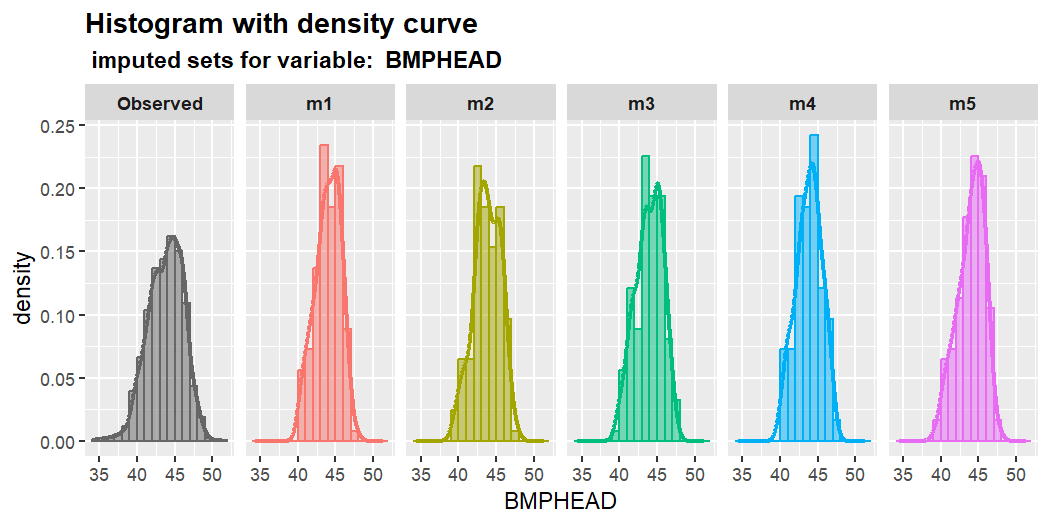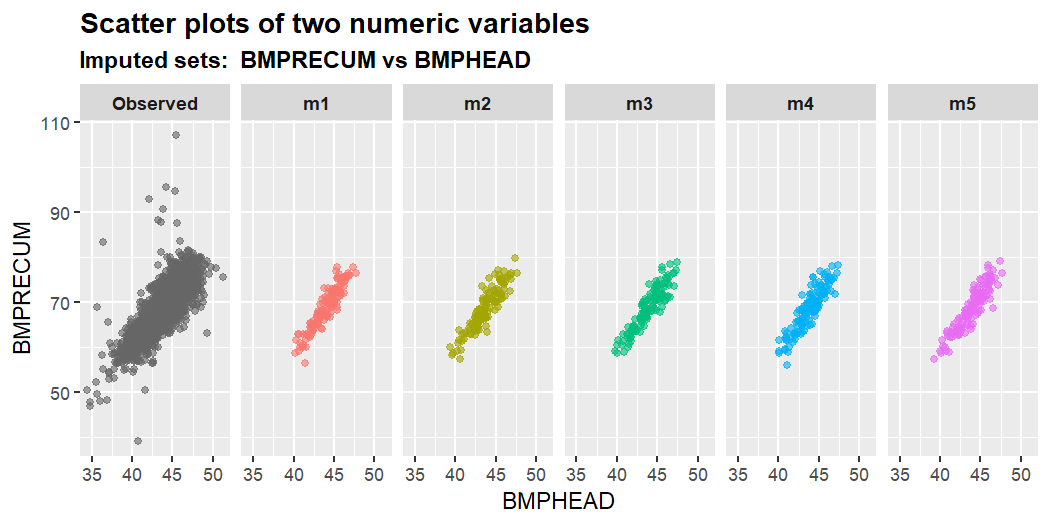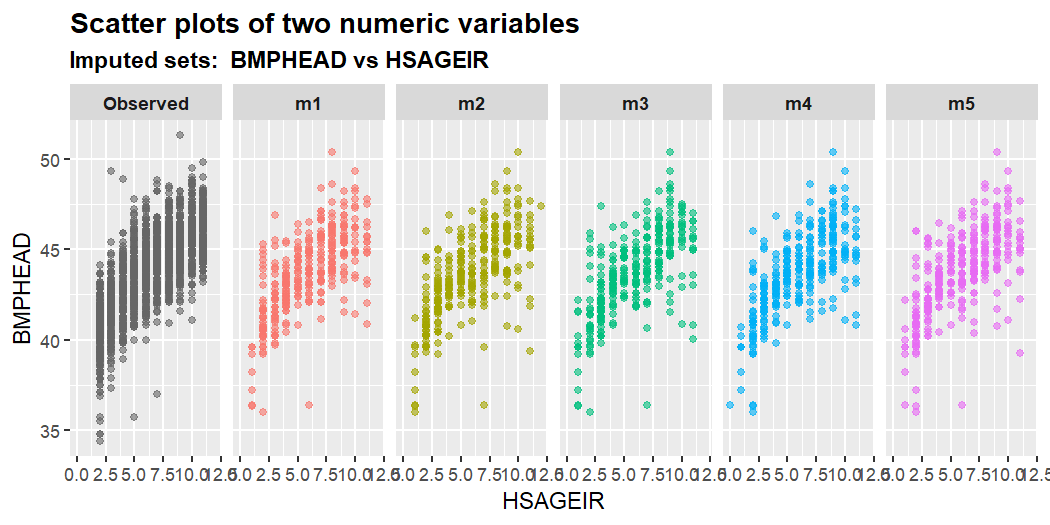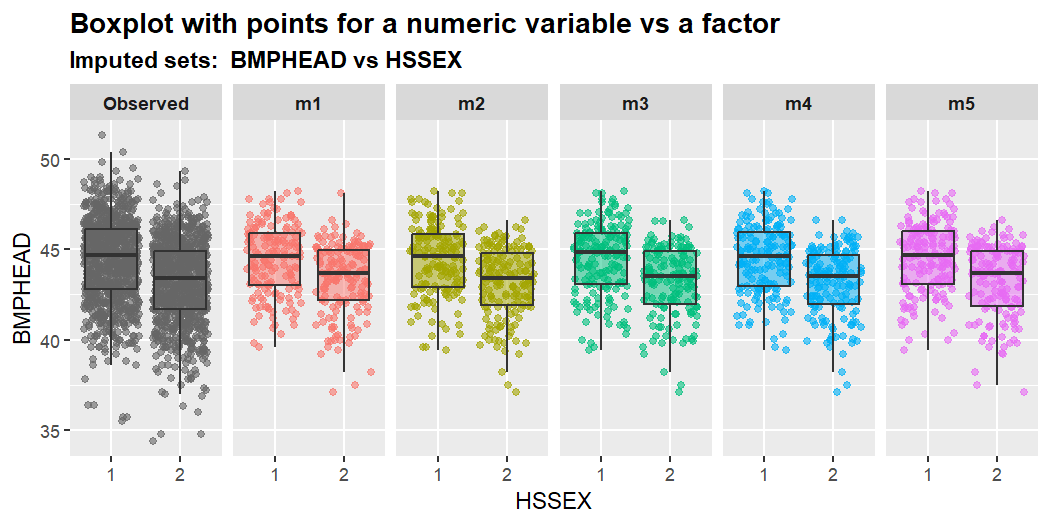The R package mixgb provides a scalable approach for multiple imputation by leveraging XGBoost, subsampling and predictive mean matching. We have shown that our method can yield less biased estimates and reflect appropriate imputation variability, while achieving high computational efficiency. For further information, please refer to our paper Multiple Imputation Through XGBoost.
References
Yongshi Deng & Thomas Lumley. (2023), Multiple Imputation Through XGBoost, Journal of Computational and Graphical Statistics, DOI: 10.1080/10618600.2023.2252501.
Tianqi Chen & Carlos Guestrin. (2016), XGBoost: A Scalable Tree Boosting System, In 22nd SIGKDD Conference on Knowledge Discovery and Data Mining.
New updates
New Release: Nov 2023
New version of the
mixgb()function has been optimized to greatly reduce imputation time for large datasets.mixgb(>=1.4.2) is compatible with both XGBoost(>=2.0.0) and XGBoost(CRAN version).
Oct 2023
- Dependency Change: Starting from mixgb version 1.3.1, the package requires XGBoost version 2.0.0 or higher. As of now, this version is not available on CRAN. To get the required version with GPU support, please download it from XGBoost GitHub Releases. Then in R, one can install XGBoost 2.0.0 and the newest version of mixgb as follows:
# Change the file path where you saved the downloaded
# XGBoost package
install.packages("path_to_downloaded_file/xgboost_r_gpu_win64_2.0.0.tar.gz",
repos = NULL)If you prefer to use the CRAN version of XGBoost, consider using an earlier version of mixgb (versions <1.3.1).
-
Now compatible with XGBoost 2.0.0! To align with XGBoost 2.0.0, mixgb introduces new parameter
deviceand removed parametersgpu_idandpredictor. Also,tree_method="hist"by default.mixgb(device="cpu", tree_method="hist",.....)mixgb(device="cuda", tree_method="hist",.....)
Now support saving imputation models in a local directory in JSON format.
May 2023
- Support logical data automatically without the need to convert it to factor type.
Now mixgb(data,...) support a dataset with the following data types:
- numeric
- integer
- factor
- logicalPlease note that variables of character type need to be manually converted to factor by users before imputation.
January 2023
- Major change of default settings for mixgb().
Our package has changed from using bootstrapping to subsampling with a default setting of subsample = 0.7. This decision is based on the discovery that although bootstrapping is generally effectively, it can introduce bias in certain scenarios. As a result, subsampling has been adopted as the default approach.
May 2022
- Introduce visual diagnostic functions for multiply imputed data.
- Use S3 instead of R6.
- Plot functions can now show masked missing data (if provided).
April 2022
- User can adjust the number of iterations with the
maxitparameter. - Both single and multiple imputation with XGBoost can use predictive mean matching.
- Bootstrapping data to obtain
mimputations is optional. Users can setbootstrap = FALSEto disable bootstrap. Users can also set sampling-related hyperparameters of XGBoost (subsample,colsample_bytree,colsample_bylevel,colsample_bynode) to be less than 1 to achieve a similar effect. - Add predicted mean matching type 0. Now the options for
pmm.typeareNULL,0,1,2or"auto"(type 2 for numeric/integer variables, no PMM for categorical variables). - Add more validation checks.
- Compatible with
data.table. - Add function
mixgb_cv()to pre-tunenroundsby cross-validation.
Under development
- In progress: To Be Announced
- Planned: To Be Announced
- Under consideration: To implement PMM type 3
Notice
- For multithreading, users can set the XGBoost nthread parameter with OpenMP support. Be advised, OpenMP support is currently disabled on MacOS.
1. Installation
You can install the development version of mixgb from GitHub with:
# install.packages("devtools")
devtools::install_github("agnesdeng/mixgb")1.1 Data cleaning before imputation
It is highly recommended to clean and check your data before imputation. Here are some common issues:
- Data should be a data frame.
- ID should be removed
- Missing values should be coded as
NAnotNaN -
Infor-Infare not allowed - Empty cells should be coded as
NAor sensible values - Variables of “character” type should be converted to “factor” instead
- Variables of “factor” type should have at least two levels
The function data_clean() serves the purpose of performing a preliminary check and fix some evident issues. However, the function cannot resolve all data quality-related problems.
cleanWithNA.df <- data_clean(rawdata)2. Impute missing values with mixgb
We first load the mixgb package and the nhanes3_newborn dataset, which contains 16 variables of various types (integer/numeric/factor/ordinal factor). There are 9 variables with missing values.
str(nhanes3_newborn)
#> tibble [2,107 × 16] (S3: tbl_df/tbl/data.frame)
#> $ HSHSIZER: int [1:2107] 4 3 5 4 4 3 5 3 3 3 ...
#> $ HSAGEIR : int [1:2107] 2 5 10 10 8 3 10 7 2 7 ...
#> $ HSSEX : Factor w/ 2 levels "1","2": 2 1 2 2 1 1 2 2 2 1 ...
#> $ DMARACER: Factor w/ 3 levels "1","2","3": 1 1 2 1 1 1 2 1 2 2 ...
#> $ DMAETHNR: Factor w/ 3 levels "1","2","3": 3 1 3 3 3 3 3 3 3 3 ...
#> $ DMARETHN: Factor w/ 4 levels "1","2","3","4": 1 3 2 1 1 1 2 1 2 2 ...
#> $ BMPHEAD : num [1:2107] 39.3 45.4 43.9 45.8 44.9 42.2 45.8 NA 40.2 44.5 ...
#> ..- attr(*, "label")= chr "Head circumference (cm)"
#> $ BMPRECUM: num [1:2107] 59.5 69.2 69.8 73.8 69 61.7 74.8 NA 64.5 70.2 ...
#> ..- attr(*, "label")= chr "Recumbent length (cm)"
#> $ BMPSB1 : num [1:2107] 8.2 13 6 8 8.2 9.4 5.2 NA 7 5.9 ...
#> ..- attr(*, "label")= chr "First subscapular skinfold (mm)"
#> $ BMPSB2 : num [1:2107] 8 13 5.6 10 7.8 8.4 5.2 NA 7 5.4 ...
#> ..- attr(*, "label")= chr "Second subscapular skinfold (mm)"
#> $ BMPTR1 : num [1:2107] 9 15.6 7 16.4 9.8 9.6 5.8 NA 11 6.8 ...
#> ..- attr(*, "label")= chr "First triceps skinfold (mm)"
#> $ BMPTR2 : num [1:2107] 9.4 14 8.2 12 8.8 8.2 6.6 NA 10.9 7.6 ...
#> ..- attr(*, "label")= chr "Second triceps skinfold (mm)"
#> $ BMPWT : num [1:2107] 6.35 9.45 7.15 10.7 9.35 7.15 8.35 NA 7.35 8.65 ...
#> ..- attr(*, "label")= chr "Weight (kg)"
#> $ DMPPIR : num [1:2107] 3.186 1.269 0.416 2.063 1.464 ...
#> ..- attr(*, "label")= chr "Poverty income ratio"
#> $ HFF1 : Factor w/ 2 levels "1","2": 2 2 1 1 1 2 2 1 2 1 ...
#> $ HYD1 : Ord.factor w/ 5 levels "1"<"2"<"3"<"4"<..: 1 3 1 1 1 1 1 1 2 1 ...
colSums(is.na(nhanes3_newborn))
#> HSHSIZER HSAGEIR HSSEX DMARACER DMAETHNR DMARETHN BMPHEAD BMPRECUM
#> 0 0 0 0 0 0 124 114
#> BMPSB1 BMPSB2 BMPTR1 BMPTR2 BMPWT DMPPIR HFF1 HYD1
#> 161 169 124 167 117 192 7 0To impute this dataset, we can use the default settings. The default number of imputed datasets is m = 5. Note that we do not need to convert our data into dgCMatrix or one-hot coding format. Our package will automatically convert it for you. Variables should be of the following types: numeric, integer, factor or ordinal factor.
# use mixgb with default settings
imputed.data <- mixgb(data = nhanes3_newborn, m = 5)2.1 Customize imputation settings
We can also customize imputation settings:
The number of imputed datasets
mThe number of imputation iterations
maxitXGBoost hyperparameters and verbose settings.
xgb.params,nrounds,early_stopping_rounds,print_every_nandverbose.Subsampling ratio. By default,
subsample = 0.7. Users can change this value under thexgb.paramsargument.Predictive mean matching settings
pmm.type,pmm.kandpmm.link.Whether ordinal factors should be converted to integer (imputation process may be faster)
ordinalAsIntegerWhether or not to use bootstrapping
bootstrapInitial imputation methods for different types of variables
initial.num,initial.intandinitial.fac.Whether to save models for imputing newdata
save.modelsandsave.vars.
# Use mixgb with chosen settings
params <- list(max_depth = 5, subsample = 0.9, nthread = 2, tree_method = "hist")
imputed.data <- mixgb(data = nhanes3_newborn, m = 10, maxit = 2,
ordinalAsInteger = FALSE, bootstrap = FALSE, pmm.type = "auto",
pmm.k = 5, pmm.link = "prob", initial.num = "normal", initial.int = "mode",
initial.fac = "mode", save.models = FALSE, save.vars = NULL,
xgb.params = params, nrounds = 200, early_stopping_rounds = 10,
print_every_n = 10L, verbose = 0)2.2 Tune hyperparameters
Imputation performance can be affected by the hyperparameter settings. Although tuning a large set of hyperparameters may appear intimidating, it is often possible to narrowing down the search space because many hyperparameters are correlated. In our package, the function mixgb_cv() can be used to tune the number of boosting rounds - nrounds. There is no default nrounds value in XGBoost, so users are required to specify this value themselves. The default nrounds in mixgb() is 100. However, we recommend using mixgb_cv() to find the optimal nrounds first.
params <- list(max_depth = 3, subsample = 0.7, nthread = 2)
cv.results <- mixgb_cv(data = nhanes3_newborn, nrounds = 100,
xgb.params = params, verbose = FALSE)
cv.results$response
#> [1] "HFF1"
cv.results$best.nrounds
#> [1] 9By default, mixgb_cv() will randomly choose an incomplete variable as the response and build an XGBoost model with other variables as explanatory variables using the complete cases of the dataset. Therefore, each run of mixgb_cv() will likely return different results. Users can also specify the response and covariates in the argument response and select_features respectively.
cv.results <- mixgb_cv(data = nhanes3_newborn, nfold = 10, nrounds = 100,
early_stopping_rounds = 1, response = "BMPHEAD", select_features = c("HSAGEIR",
"HSSEX", "DMARETHN", "BMPRECUM", "BMPSB1", "BMPSB2",
"BMPTR1", "BMPTR2", "BMPWT"), xgb.params = params, verbose = FALSE)
cv.results$best.nrounds
#> [1] 13Let us just try setting nrounds = cv.results$best.nrounds in mixgb() to obtain 5 imputed datasets.
imputed.data <- mixgb(data = nhanes3_newborn, m = 5, nrounds = cv.results$best.nrounds)3. Visualize multiply imputed values
It is crucial to assess the plausibility of imputations before doing an analysis. The mixgb package provides several visual diagnostic functions using ggplot2 to compare multiply imputed values versus observed data.
We will demonstrate these functions using the nhanes3_newborn dataset. In the original data, almost all missing values occurred in numeric variables. Only seven observations are missing in the binary factor variable HFF1.
library(mixgb)
colSums(is.na(nhanes3_newborn))
#> HSHSIZER HSAGEIR HSSEX DMARACER DMAETHNR DMARETHN BMPHEAD BMPRECUM
#> 0 0 0 0 0 0 124 114
#> BMPSB1 BMPSB2 BMPTR1 BMPTR2 BMPWT DMPPIR HFF1 HYD1
#> 161 169 124 167 117 192 7 0In order to visualize some imputed values for other types of variables, we create some extra missing values in HSHSIZER (integer), HSAGEIR (integer), HSSEX (binary factor), DMARETHN (multiclass factor) and HYD1 (Ordinal factor) under the missing completely at random (MCAR) mechanism.
withNA.df <- createNA(data = nhanes3_newborn, var.names = c("HSHSIZER",
"HSAGEIR", "HSSEX", "DMARETHN", "HYD1"), p = 0.1)
colSums(is.na(withNA.df))
#> HSHSIZER HSAGEIR HSSEX DMARACER DMAETHNR DMARETHN BMPHEAD BMPRECUM
#> 211 211 211 0 0 211 124 114
#> BMPSB1 BMPSB2 BMPTR1 BMPTR2 BMPWT DMPPIR HFF1 HYD1
#> 161 169 124 167 117 192 7 211We then impute this dataset using mixgb() with default settings. After completion, a list of five imputed datasets is assigned to imputed.data. Each imputed dataset will have the same dimension as the original data.
imputed.data <- mixgb(data = withNA.df, m = 5)By using the function show_var(), we can see the multiply imputed values of the missing data for a given variable. The function returns a data.table of m columns, each of which represents a set of imputed values for the variable of interest. Note that the output of this function only includes the imputed values of missing entries in the specified variable.
show_var(imputation.list = imputed.data, var.name = "BMPHEAD",
original.data = withNA.df)
#> m1 m2 m3 m4 m5
#> 1: 44.48437 42.40263 44.81512 44.23953 43.26088
#> 2: 42.27523 41.39620 42.05612 42.56915 42.26706
#> 3: 43.38593 42.90775 43.08914 42.24798 43.07787
#> 4: 44.14684 43.17070 43.51343 43.59421 43.96187
#> 5: 41.42059 40.60042 40.84894 41.08277 41.09366
#> ---
#> 120: 45.84540 45.73336 45.61261 45.63473 45.36967
#> 121: 44.82779 45.72536 45.70374 44.93923 44.94569
#> 122: 41.58113 41.92926 41.42997 41.95879 42.23804
#> 123: 43.82690 44.91631 43.63697 43.93151 44.76704
#> 124: 45.74449 43.57767 45.24529 43.95994 44.38604
show_var(imputation.list = imputed.data, var.name = "HFF1", original.data = withNA.df)
#> m1 m2 m3 m4 m5
#> 1: 2 2 2 2 2
#> 2: 2 2 2 2 2
#> 3: 2 1 2 2 2
#> 4: 2 2 2 1 2
#> 5: 1 1 1 2 1
#> 6: 1 1 2 1 2
#> 7: 2 2 1 2 2The mixgb package provides the following visual diagnostics functions:
Single variable:
plot_hist(),plot_box(),plot_bar();Two variables:
plot_2num(),plot_2fac(),plot_1num1fac();Three variables:
plot_2num1fac(),plot_1num2fac().
Each function returns m+1 panels that enable a comparison between the observed data and m sets of imputed values for the missing data.
Here are some examples. For more details, please check the vignette on GitHub Visual diagnostics for multiply imputed values.
plot_hist(imputation.list = imputed.data, var.name = "BMPHEAD",
original.data = withNA.df)
plot_2num(imputation.list = imputed.data, var.x = "BMPHEAD",
var.y = "BMPRECUM", original.data = withNA.df)
plot_2num(imputation.list = imputed.data, var.x = "HSAGEIR",
var.y = "BMPHEAD", original.data = withNA.df)
plot_1num1fac(imputation.list = imputed.data, var.num = "BMPHEAD",
var.fac = "HSSEX", original.data = withNA.df)
4. Impute new unseen data using a saved imputer object
Users need to specify a local directory in the parameter save.models.folder in the main function mixgb(). Models will be save as JSON format by calling xgb.save() internally. Saving XGBoost models in this way instead of using saveRDS in R is recommended by XGBoost. This can ensure that the imputation models can still be used in later release of XGBoost.
# obtain m imputed datasets for train.data and save
# imputation models
mixgb.obj <- mixgb(data = train.data, m = 5, save.models = TRUE,
save.models.folder = "C:/Users/.....")
saveRDS(object = mixgb.obj, file = "C:/Users/.../mixgbimputer.rds")If users specify the save.models.folder, the return object will include the following:
imputed.data: a list ofmimputed datasets for training dataXGB.models: a list of directories ofmsets of XGBoost models for variables specified insave.vars.params: a list of parameters that are required for imputing new data usingimpute_new()later on.XGB.save: a parameter indicates whetherXGB.modelsare the saved models or the directories for the saved models.
As the mixgb.obj does not contain the models themselves, users need not worry about saving this object via saveRDS(). For later use, one can load the object into R and impute new data.
mixgb.obj <- readRDS(file = "C:/Users/.../mixgbimputer.rds")
set.seed(2022)
n <- nrow(nhanes3)
idx <- sample(1:n, size = round(0.7 * n), replace = FALSE)
train.data <- nhanes3[idx, ]
test.data <- nhanes3[-idx, ]
test.imputed <- impute_new(object = mixgb.obj, newdata = test.data)
test.imputedDepreciated
Warning: In previous versions, users can save models without specifying the local directory. This is not recommended but users can still do this using the old version mixgb0(). Note that this function will be depreciated in the near future.
First, let us split the nhanes3_newborn dataset into training data and test data.
library(mixgb)
data("nhanes3_newborn")
set.seed(2022)
n <- nrow(nhanes3_newborn)
idx <- sample(1:n, size = round(0.7 * n), replace = FALSE)
train.data <- nhanes3_newborn[idx, ]
test.data <- nhanes3_newborn[-idx, ]We can use the training data to generate m imputed datasets and save their imputation models. To achieve this, users need to set save.models = TRUE. By default, imputation models for all variables with missing values in the training data will be saved (save.vars = NULL). However, it is possible that unseen data may have missing values in other variables. To be thorough, users can save models for all variables by setting save.vars = colnames(train.data). Note that this may take significantly longer as it requires training and saving a model for each variable. In cases where users are confident that only certain variables will have missing values in the new data, it is advisable to specify the names or indices of these variables in save.vars rather than saving models for all variables.
# obtain m imputed datasets for train.data and save
# imputation models
mixgb.obj <- mixgb0(data = train.data, m = 5, save.models = TRUE,
save.vars = NULL)When save.models = TRUE, mixgb() will return an object containing the following:
imputed.data: a list ofmimputed datasets for training dataXGB.models: a list ofmsets of XGBoost models for variables specified insave.vars.params: a list of parameters that are required for imputing new data usingimpute_new()later on.
We can access the m imputed datasets from the saved imputer object by using $imputed.data.
train.imputed <- mixgb.obj$imputed.data
# the 5th imputed dataset
head(train.imputed[[5]])
#> HSHSIZER HSAGEIR HSSEX DMARACER DMAETHNR DMARETHN BMPHEAD BMPRECUM BMPSB1
#> 1: 7 2 1 1 1 3 44.5 68.7 9.0
#> 2: 4 3 2 2 3 2 42.6 67.1 8.8
#> 3: 3 9 2 2 3 2 46.5 64.3 8.6
#> 4: 3 9 2 1 3 1 46.2 68.5 10.8
#> 5: 5 4 1 1 3 1 44.7 63.0 6.0
#> 6: 5 10 1 1 3 1 45.2 72.0 5.4
#> BMPSB2 BMPTR1 BMPTR2 BMPWT DMPPIR HFF1 HYD1
#> 1: 10.4 13.6 12.6 8.05 1.701 2 1
#> 2: 8.8 13.3 12.2 8.70 0.102 2 1
#> 3: 8.0 10.4 9.2 8.00 0.359 1 3
#> 4: 10.0 16.6 16.0 8.98 0.561 1 3
#> 5: 5.8 9.0 9.0 7.60 2.379 2 1
#> 6: 5.4 9.2 9.4 9.00 2.173 2 2To impute new data with this saved imputer object, we can use the impute_new() function. Users can choose whether to use new data for initial imputation. By default, the information of training data is used to initially impute the missing data in the new dataset (initial.newdata = FALSE). After this, the missing values in the new dataset will be imputed using the saved models from the imputer object. This process will be considerably faster because it will not involve rebuilding the imputation models.
test.imputed <- impute_new(object = mixgb.obj, newdata = test.data)If PMM is used in mixgb(), predicted values of missing entries in the new dataset will be matched with donors from the training data. Additionally, users can set the number of donors to be used in PMM when imputing new data. The default setting pmm.k = NULL indicates that the same setting as the training object will be used.
Similarly, users can set the number of imputed datasets m in impute_new(). Note that this value has to be less than or equal to the m value specified in mixgb(). If this value is not specified, the function will use the same m value as the saved object.
test.imputed <- impute_new(object = mixgb.obj, newdata = test.data,
initial.newdata = FALSE, pmm.k = 3, m = 4)Newest Version (XGBoost >= 2.0.0, mixgb >= 1.3.1)
Please download the Newest version of XGBoost with GPU support via XGBoost GitHub Releases.
# Change the file path where you saved the downloaded
# XGBoost package
install.packages("path_to_downloaded_file/xgboost_r_gpu_win64_2.0.0.tar.gz",
repos = NULL)Then users can install the newest version of our package mixgb in R.
To utilize the GPU version of mixgb(), users can simply specify device = "cuda" in the params list which will then be passed to the xgb.params argument in the function mixgb(). Note that by default, tree_method = "hist" from XGBoost 2.0.0.
Old Version (XGBoost < 2.0.0, mixgb < 1.3.1)
The xgboost R package pre-built binary on Linux x86_64 with GPU support can be downloaded from the release page https://github.com/dmlc/xgboost/releases/tag/v1.4.0
The package can then be installed by running the following commands:
# Install dependencies
$ R -q -e "install.packages(c('data.table', 'jsonlite'))"
# Install XGBoost
$ R CMD INSTALL ./xgboost_r_gpu_linux.tar.gzThen users can install package mixgb in R.
To utilize the GPU version of mixgb(), users can simply specify tree_method = "gpu_hist" in the params list which will then be passed to the xgb.params argument in the function mixgb(). Other adjustable GPU-realted arguments include gpu_id and predictor. By default, gpu_id = 0 and predictor = "auto".